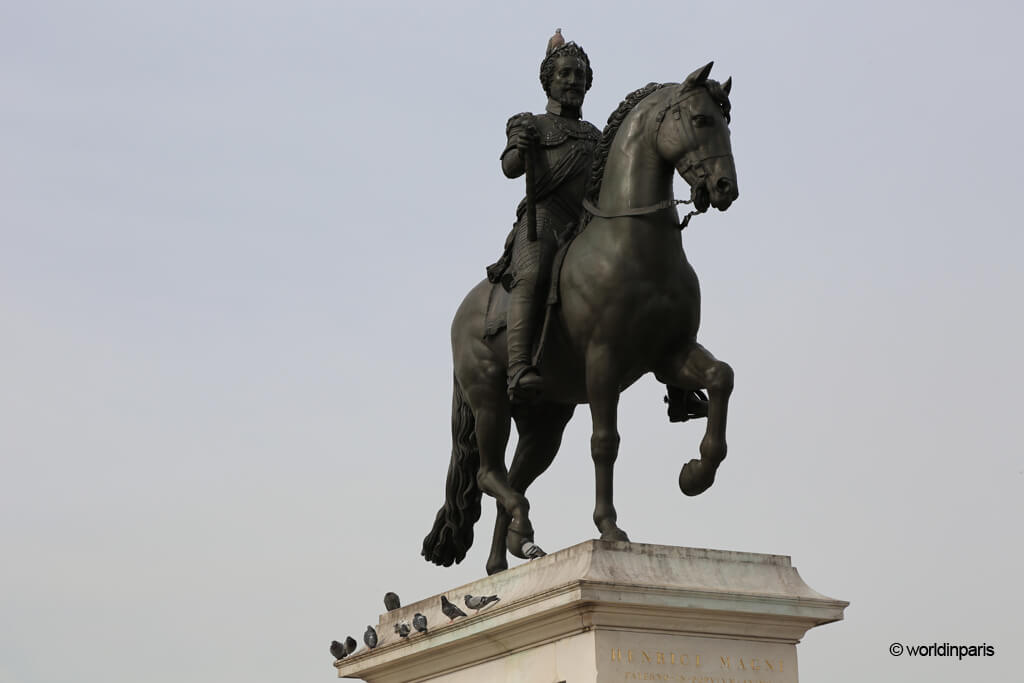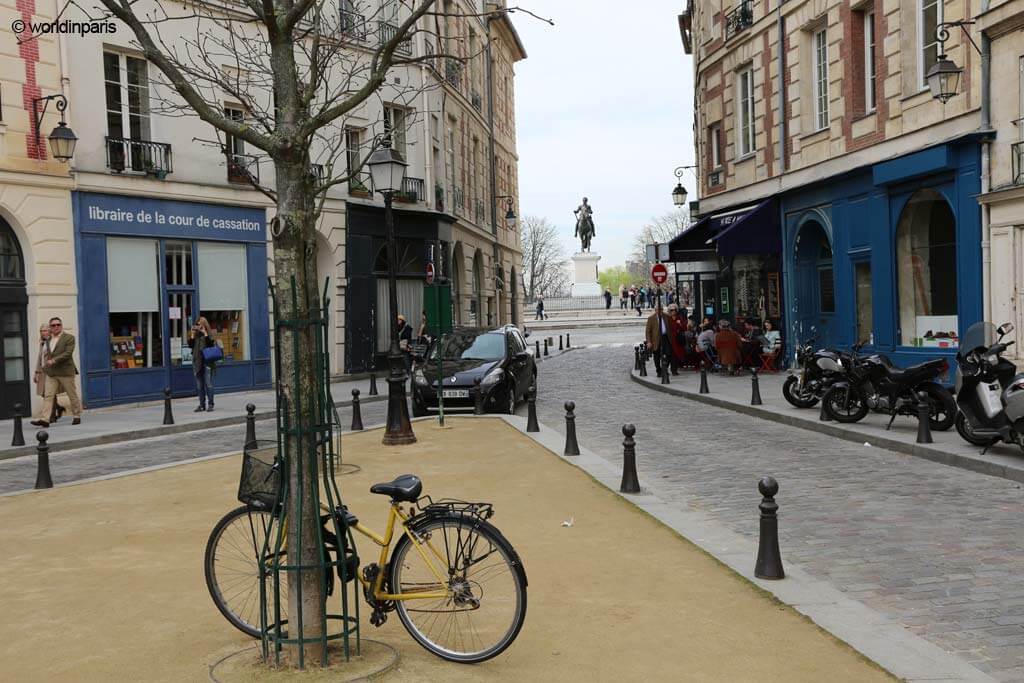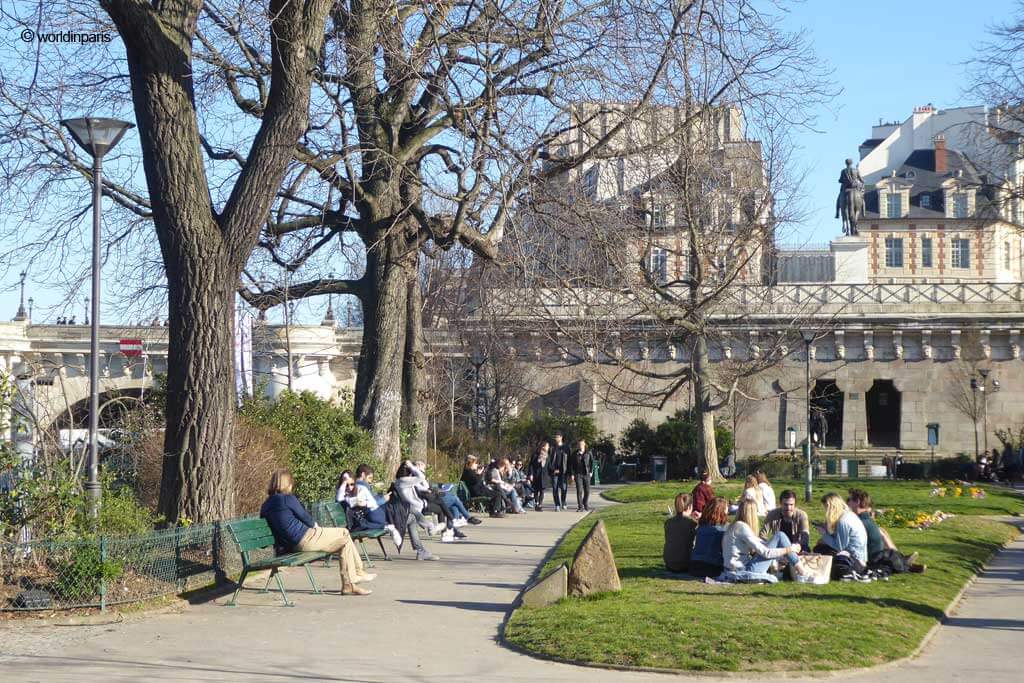It’s impossible to miss the equestrian statue of King Henri IV (1553-1610), located on the Pont Neuf between the lovely Place Dauphine and Square du Vert Galant on Ile de la Cité. Do you like it? Unlike other sculptures in Paris, famous for their design, the statue Henri IV is mostly known for its misadventures and legends related to it.
Unfortunately, King Henri IV never saw the sculpture dedicated to him, as he was assassinated in 1610, before the work was finished. The statue was inaugurated by his heir, Louis XIII, in 1614. Here’s the story:

Construction of the Statue Henri iV on Pont Neuf

The bronze statue was commissioned by Queen Marie de Médicis (1575-1642) to pay tribute to his husband, King Henri IV. For the location, the Queen chose the Pont Neuf, which construction finished in 1607.
For the design and execution of the sculpture, the Queen chose the best artists of the time in Florence, her birthplace: Jean Bologne (a flemish sculptor, student of Michelangelo in Florence) for the horse and Pietro Tacca and his student for the King’s statue.
Duke Cosimo II di Medici, the Queen’s cousin, ordered the transportation of the sculpture from Florence to Livorno to be shipped on a vessel direction to Paris. The nave left the port of Livorno in November 1613, but it was the victim of a pirate attack and sank in the Gulf of Genova, not far from the city of Savona.
The royal sculpture spent one month submerged in the waters of the Mediterranean Sea until it was rescued at a great expense. The statue was loaded on a new vessel and navigated through the Spanish coast, Gibraltar, and then up the Atlantic Ocean to Le Havre in France. A flat-bottom vessel transported the statue on the Seine River upstream to Paris, where it was finally inaugurated on 24 August 1614 by Louis XIII.
The equestrian statue of King Henri IV had a peaceful existence until the French Revolution, when it was torn down during the riots of 10 August 1792. The bronze of the sculpture was melted and used to fabricate canons.
A New Statue Henri iV on the Pont Neuf

During the Consulate and the Empire, the location remained empty. With the return of the Bourbons, the sculptor Francois Frédéric Lemot was chosen to design a new equestrian sculpture inspired by the few remains of the former statue. Visitors can still see these remains in the Musée de Carnevalet in Le Marais.
For the new sculpture, several statues of Napoleon and his generals were melted: the Napoleon on the column in Place de Vendôme and the Napoléon de Houdon on the column of Boulogne.
During the execution of the new equestrian sculpture, four little boxes containing official documents, medals, and three works related to King Henri IV were placed in the belly of the horse.
According to a legend, Balthazar Mesnet, one of the carvers of the statue and a loyal Bonapartist, hide several pamphlets and antiroyalist documents inside the statue to revenge his dear Emperor.
In 1820 the sculpture’s pedestal was completed with some basreliefs showing King Henri distributing food to the poor (south) and King Henri’s entrance in Paris in 1594 (north). The statue was listed as a Historical Monument in 1992.
Surprises during the Restoration Works
Due to the pollution and corrosion, the Pont Neuf and the statue King Henri iV went through a deep restoration program from 2005 to 2009, which was seen as the perfect chance to explore the sculpture’s mysterious entrails.
The workers could introduce a small endoscopic camera in the sculpture through a small cut on the King’s back. They could find the four referenced boxes in the horse’s belly (currently kept in the Armoire de Fer in the Archives Nationals – Musée de l’Histoire de France). Inside the King’s bottom, the workers also found some unlisted items, such as documents, a metallic box, and a wooden cylinder. In the King’s head, they found a metallic cylinder with the name of Mesnet engraved.
Unfortunately, these items are not in good condition to be deciphered. The only document the experts could decypher until now only contains a list of master founders and carvers that participated in the creation of the new equestrian sculpture. Perhaps one day, with new techniques, King Henri will be able to reveal all his secrets.

